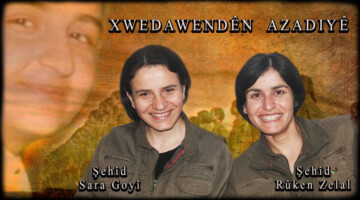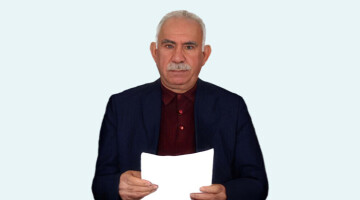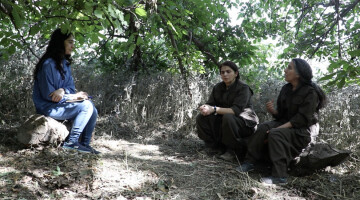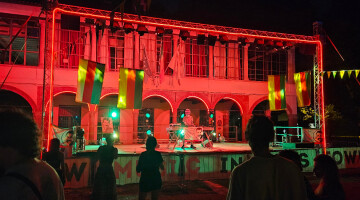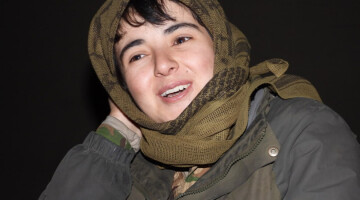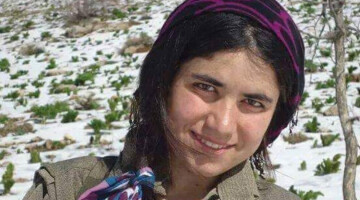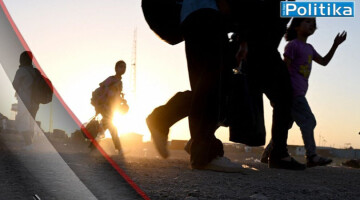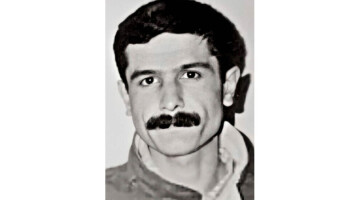Since 14 April, there has been a large-scale Turkish attack on the guerrilla-held Medya Defense Zones in southern Kurdistan (northern Iraq). The Zap region in particular is the focus of the attacks, but Metîna and Avaşîn are also under constant attack. Since 17 April, the Turkish army has been trying to establish itself on the ground, but it is encountering fierce resistance from the guerrillas, who are inflicting heavy losses on the Turkish army with a combination of tunnel warfare and highly mobile units. The Turkish army is obviously unable to continue its invasion by conventional means and therefore resorts to the use of chemical weapons. These banned weapons are fired at the guerrillas from aircraft, but also from howitzers and mortars. The war tunnels are especially targeted by these war criminal attacks.
Reports from the region show that the areas of Çiyareş, Şikefta Birîndara, Şehîd Şahîn, Werxelê and Kuro Jahro are particularly affected by the Turkish army’s use of chemical weapons. It is not only the guerrillas who are attacked, but large areas of untouched nature are also contaminated in the long term.
Last year, too, the Turkish army relied massively on the use of chemical weapons. This year, the use of these banned weapons has been expanded. Currently, gases that smell like soap and chlorine and are grey or white are being used.
Poison gas settles everywhere
The Şehîd Berxwedan position in the Şehîd Şahîn resistance area was held by a guerrilla unit against the Turkish army for almost two months. During the 47 days of resistance, the Turkish army used all its technology against a guerrilla unit under the command of Bager Gever and Avzem Çiya. On 2 June 2022, before he and three of his comrades fell, Bager Gever said over the radio: "They used chemical weapons several times. The residues of these gases stick to the tunnels. They become active again when they are moved. This residue sticks to our friend's hair and clothes, we have documented this situation."
Yellow gas and odourless gases
The use of chemical weapons was again proven by the footage from the same position released by ANF on 25 June 2022. In the footage, a guerrilla fighter wearing a gas mask with chemical residues of black and white powder on it explains that the gases used have a very strong smell. The same fighter reports that these gases directly attack the respiratory tract and rob the air, while the walls of the tunnel turn dark due to the gas.
He also confirms that the residues are still active and can continue to kill when they are raised as dust and mix with the air again. However, as the fighter reports, other substances such as pepper gas and a yellow gas were also used. The yellow gas could be mustard gas (sulphur rust) or chlorine. In particular, the yellow liquid residue shown in the video points to mustard gas. In the case of a massive use of mustard gas, the formation of liquid residues is likely, as the toxic substance is liquid at room temperature and has a yellowish oily form. Furthermore, completely odourless poisonous gases are also used.
Footage from state television confirms yellow poison gas
In a documentary about the Turkish army's "anti-terror unit" broadcast on TRT 1 in 2004, a Turkish soldier was shown testing the use of "tear gas". In the footage, after dropping an explosive bomb into a cave, a "tear gas bomb" is thrown and yellow smoke rises. Experts who analysed the footage in 2011 determined at the time that it was not tear gas, but another chemical weapon. The use of tear gas is also banned in warfare.
779 chemical weapons used in two months
In a balance sheet, the HPG Press Centre reported 779 uses of chemical weapons together with explosives between 14 April and 14 June. At least 13 HPG and YJA-Star fighters were killed by chemical weapons in the first month of the war. Of these guerrilla fighters, eight fell at Çiyareş and five at Kuro Jahro.
HPG sources and ANF correspondents in the region reported that the Turkish army has been steadily expanding the scope of the invasion operation and increasing its use of banned chemical weapons in recent weeks. According to the report, the Turkish army has used banned chemical weapons at least 162 times between 15 June and 5 July 2022.
The balance sheet of the last 20 days
In the last 20 days alone, the following chemical weapons use was detected:
15 June: HPG guerrilla units stopped the Turkish army's attempt to approach Şehîd Zemanî's war tunnels in the Girê Hekarî resistance area. The Turkish army was forced to withdraw. The war tunnels were then shelled, emitting a grey gas smelling of detergent.
16 June: Soldiers lit fires in front of the war tunnels in Werxelê and used poison gas four times.
20 June: The war tunnels of Şehîd Hêjar in the Girê Hekarî resistance area were attacked five times with chemical weapons.
21 June: The war tunnels in the Werxelê resistance area were attacked five times with chemical weapons. On the same day, the war tunnels at Girê Şehîd Çekdar were also shelled with chemical weapons.
24 June: The war tunnels Şehîd Çekdar, Şehîd Yıldız and Şehîd Yunus in the Girê Cûdî resistance area were attacked 13 times with chemical weapons and explosives. On the same day, the resistance areas of Şikefta Birîndara and Karker in the Zap region were also attacked 13 times with chemical weapons and the Werxelê resistance area was attacked four times with chemical weapons and explosives.
25 June: The Şehîd-Yunus war tunnels in the Girê Cûdî resistance area were attacked 12 times with chemical weapons and explosives.
25-26 June: The resistance areas of Şehîd Berxwedan and Şikefta Birîndara were attacked 24 times with chemical weapons and explosives on both days.
28 June: The war tunnels in the Girê Cûdî, Karker and Şikefta Birîndara resistance areas were attacked seven times with chemical weapons and explosives.
30 June: The war tunnels of Girê Şehîd Rêber in the Karker resistance area were attacked three times with chemical weapons and explosives.
1 July: The war tunnels in Şikefta Birîndara, Girê FM and the Girê Cûdî Area resistance area were attacked eleven times with chemical weapons and explosives. The chemical weapons used smelled of bleach and chlorine.
2 July: The war tunnels in Kokerê, Şikefta Birîndara, Werxelê, Girê Hekarî and the Girê Cûdî Resistance Area were attacked 17 times with chemical weapons and explosives.
3 July: The Turkish army attacked the resistance areas of Girê Cûdî, Şikefta Birîndara, Karker and Kokerê 21 times with chemical weapons and explosives. A white gas was used in the process.
4 July: The Turkish army extended its invasion operation into the areas west of the Zap towards the Girê Amêdî Front and intensively used chemical warfare agents against guerrilla positions and war tunnels. The positions at Girê Hekarî, Girê Cûdî, Şikefta Birîndara, Şehîd Umîd and Koker were attacked 22 times with chemical weapons and explosives. HPG reported that six different types of chemical weapons were used in this attack.
Turkey can break international law of war with impunity
The Organisation for the Prohibition of Chemical Weapons (OPCW), of which the Turkish state has been a member since 1997, prefers to remain silent. Despite all the HPG reports on the use of chemical weapons and the calls of Kurdish institutions and organisations, the OPCW was not even willing to answer ANF's question about whether the OPCW would open an investigation.
Although there were protests against the chemical weapons use in front of the OPCW building throughout May and June, the organisation has not yet issued a statement. Moreover, OPCW representatives blocked delegations' attempts to hold talks with them and even refused to accept a dossier containing concrete documents and evidence of chemical weapons use.
The commander of the People's Defense Centre (HSM), Murat Karayılan, sees a link between the NATO accession of Finland and Sweden and the behaviour of the OPCW. He says Turkey bought its silence by playing the veto card.
In an address to the guerrillas, Karayılan said on 20 June 2022: "The fascist state of Turkey is using the NATO card against the Kurdish people. It is using its right to veto the accession of Sweden and Finland so that no objections are raised against the use of chemical weapons. This is the first objective of Turkey's action; the second objective is the lifting of the arms embargo. It is essentially a matter of getting both demands met."



